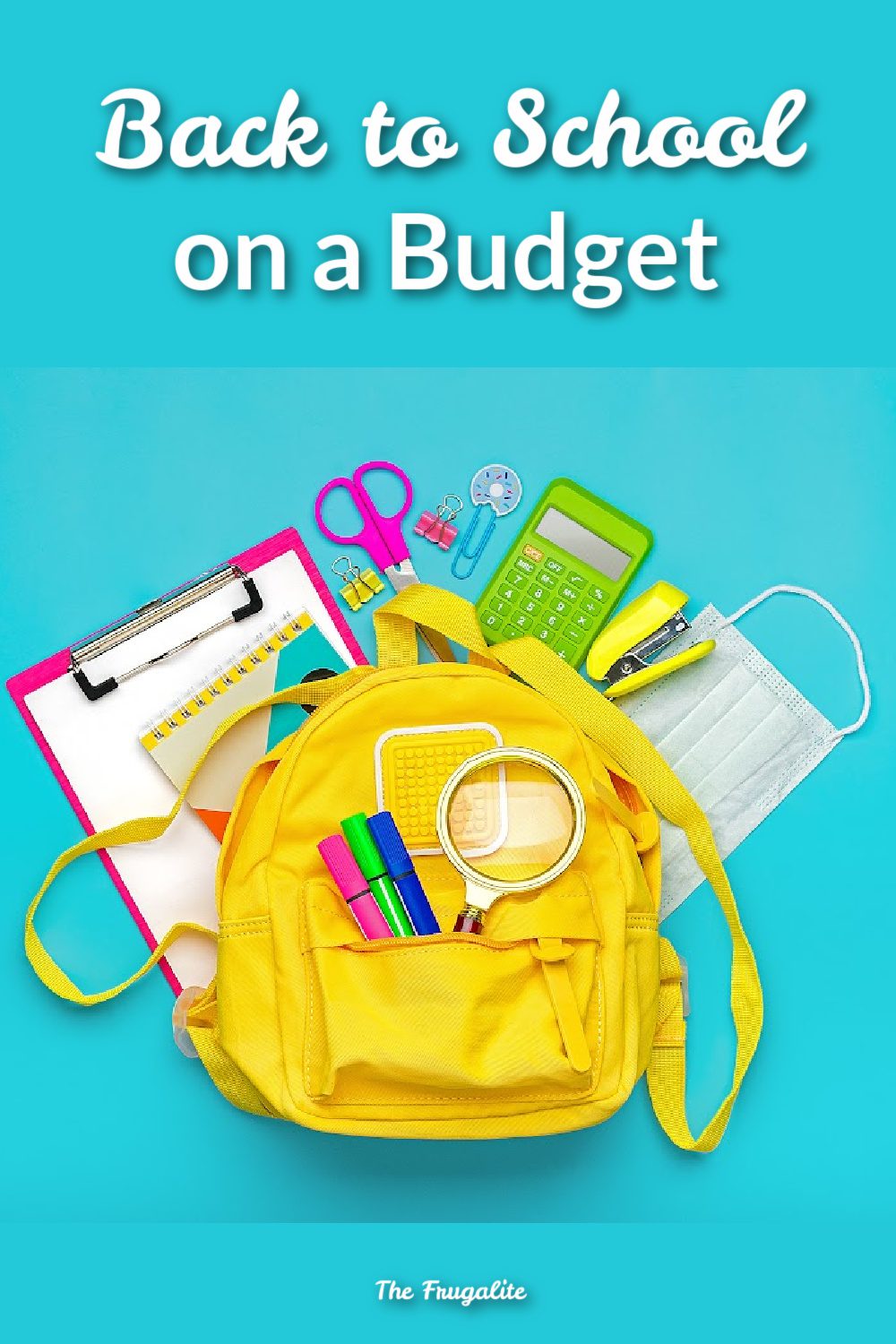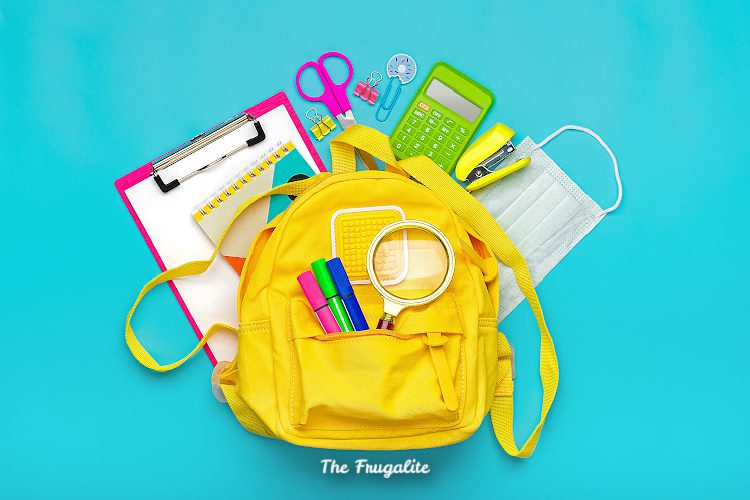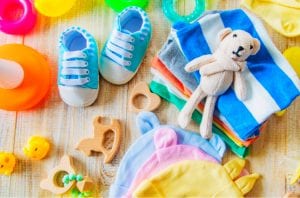(Psst: The FTC wants me to remind you that this website contains affiliate links. That means if you make a purchase from a link you click on, I might receive a small commission. This does not increase the price you’ll pay for that item nor does it decrease the awesomeness of the item. ~ Daisy)
By the author of The Ultimate Guide to Frugal Living and What to Eat When You’re Broke
Back to school time means there won’t be any more daily cries of, “I’m booooooored!” It means the end of those impromptu trips to the beach or the pool. It means that your house will be a little tidier, you will get a little more done, and your kids will get to see friends that they haven’t seen since the school doors closed at the beginning of the summer.
Unfortunately, it also means that it’s time for mom and dad to spend some money. When many Americans can barely make ends meet from month to month without any additional expenses, back-to-school time can be the source of a great deal of stress.
While we, as adults, can tighten the budget relentlessly on items for ourselves, many people have a much more difficult time enforcing frugality on their children. But by ignoring the financial restraints and spending on our kids with reckless abandon, I don’t believe we are doing them any favors. Showering your children with false prosperity doesn’t prepare them for thriving in this world. If times are tough, your kids need to know it. (Here’s how to talk to them about financial problems.)
Figure Out Your Budget
First, a back-to-school budget is a must, and it depends on your personal means. No matter what your child believes they “need,” it has to fit into the budget. For years, I have used the envelope method for things like Christmas and back-to-school shopping. It’s fair, it’s efficient, and it’s tangible. This way, I not only stay within budget, but I teach my kids about budgeting also.
Both of my daughters are very financially responsible and handle money well because they have been making their purchases fit the existing budget since they were old enough to perform the necessary math. There have been years they made poor choices they regretted. However, by allowing them to do this, they learned a lesson you can’t teach them with a verbal warning.
- Make two envelopes with each child’s name on them – one for supplies and clothes. Into the envelope goes a designated amount of cash – this may be $20, $100, or more, depending on your personal finances. (When making the back-to-school budget, be sure to keep your other expenses in mind – you still have to eat and pay your bills!)
- Sit down with the kids and a pile of back-to-school fliers and tell them their budgets. Expect to hear lots of cheering and excitement as the large number floats around in their heads. Then hand them a notebook so they can write down what they need in two columns. Mark one column “supplies” and the other “clothes.”
Critical Teaching Moment: No, Don’t Increase the Budget!
Once they have written up their lists, have them go through the fliers and choose the things they want. Generally, their desires will significantly outstrip their budgets.
This is the time to teach them to figure out which of the items are necessary and which are optional. Have the kids consider their lists. Are there any items they have from last year that would allow them to strike some things off the wish list and free up some more funds? Do they actually NEED a new lunch box or binder, or will last year’s suffice for just a little longer? If they get the $80 jeans, can they manage to purchase the rest of their wardrobe for only $20?
Spend a couple of days brainstorming. Let your kids think about their budgets and their lists. You may be surprised at their solutions for stretching the money. They can search online for deals, and they can get crafty and remake some of their own items. Give them the freedom to be creative and to think for themselves.
Go Shopping! Here Are the Rules.
When you are in the checkout line, have your kids pay from their envelopes. Receipts go back into the appropriate envelope, making it easier for them to see where their money has gone or to make returns or exchanges if necessary. If they are out of money, they are finished shopping unless they opt to return for a refund. This is the key element of teaching your kids to budget. If you don’t enforce this part of the exercise, you’ve completely wasted your time with the rest of it.
My kids always had jobs in the summer – they babysat, did farm chores, and did one-time projects like cleaning out the garage, painting the fence, etc. While they are certainly allowed to supplement their budgets with their own money, quite often, they saved for a bigger item or for spending money throughout the school year instead of spending their cash frivolously. Other times, they save up for one big-ticket clothing item that they know I won’t be buying for them.
Here Are Some Ways For Kids to Stretch Their Back-to-School Dollars
- Clean your room. You might find pens, pencils, and art supplies – instead of buying new ones, you can allocate that money to other things.
- Check out the business supply store. Our local Staples has a great selection of 25 cent school supplies.
- Check the fliers for loss leaders. Wal-Mart is selling loose-leaf paper two packs for $1. Just don’t fall into the marketing trap of buying the overpriced items that the loss leaders display.
- Visit thrift stores. You can get nice things for a fraction of the price if you shop carefully. Plus, no one else can copy your unique vintage style.
- Go to the dollar store. Items like pens, pencils, sharpeners, pencil cases, etc., can be found inexpensively there.
- Focus on accessories. Cool accessories can make last year’s stuff look new.
- Look at new ways to wear old clothes. (This works better for girls than boys.) Last year’s cool dress might be a cute top with leggings this year.
- Refashion old clothes. Turn outgrown jeans into a purse, or use pieces of old stuff to make headbands, scarves, or other accessories.
- Do a dye makeover. If you have some faded black items from the previous year, invest in a package of clothing dye, like RIT. They’ll come out looking as good as new. You can also get other colors and dye things like jeans or tee shirts. If you have an item with a stain that won’t come out, dying it a darker color than the stain can give it a new life.
- Wait until after school starts. If you wait until after the first day of school, you may find that you require different items than expected. Shop for all but the most basic needs after you have gotten your list from the school. Many clothing items go on sale a few weeks after school starts, which will help your money go further.
New Beginnings
I have always loved back-to-school time, even now that my kids are no longer little. It seems like a time for new beginnings, much like New Year’s Day. We make new resolutions for the school year ahead, we get organizational goodies and new pens while they’re on sale, and we think about the new habits we want to start as summer comes to an end.
Back-to-school doesn’t have to mean emptying your bank account or racking up your credit card bill. Shop responsibly and teach your kids the value of a budget.
What are your best thrifty back-to-school tricks? Is there anything in this article you would try, or have tried? Share them in the comments and let’s get our kids dressed and ready on a dime.
About Daisy
Daisy Luther is a coffee-swigging, adventure-seeking, globe-trotting blogger. She is the founder and publisher of three websites. 1) The Organic Prepper, which is about current events, preparedness, self-reliance, and the pursuit of liberty; 2) The Frugalite, a website with thrifty tips and solutions to help people get a handle on their personal finances without feeling deprived; and 3) PreppersDailyNews.com, an aggregate site where you can find links to all the most important news for those who wish to be prepared. Her work is widely republished across alternative media and she has appeared in many interviews.
Daisy is the best-selling author of 5 traditionally published books, 12 self-published books, and runs a small digital publishing company with PDF guides, printables, and courses at SelfRelianceand Survival.com You can find her on Facebook, Pinterest, Gab, MeWe, Parler, Instagram, and Twitter.












8 thoughts on “Back to School on a Budget”
It’s been a few years, but
1. All of the mothers in the neighborhood brought clean, gently used clothing to a specific spot, where we traded ours for theirs. Saved a lot, except for shoes. Most kids wore them threadbare.
2. Whenever the grandparents sent money, the rule was half into the bank, half to spend. My son and daughter learned to put money aside for their wants ie if they wanted designer shoes, they paid for them. We did not pay for labels.
3. During the year I shopped for supplies. A couple of dollars here and there went a long way to ease the pain in August.
4. Every Sunday night, we made lunch sandwiches for the week and froze them. When the kids were older, they could assemble the chips/fruit/whatever themselves. If they wanted to buy a particular lunch (believe it or not some were good), I paid for a ten punch meal ticket they could use. When it was done, it was done.
5. When the gently used clothes were outgrown, we would watch for sales to replace them. We also felt that each child did not need a dozen jeans or a dozen tops. We restricted them to 2 or 3 pair of bottoms (one fit for church), and 3 or 4 tops per season. They also had a pair of good shoes which we purchased and then their sneakers, which we gave them money towards. We insisted that all garments were clean and presentable, which we taught them the how’s. They took care of all their garments themselves.
6. We paid for personal products out of our budget. It would not be fair to have daughter pay more than son. Later when they had part time jobs, they took care of it.
7. We paid for really good quality backpacks, which far outlasted the cheapies.
I suppose we sound rather cheap, but both kids have good jobs and money in the bank, so we must have done something right.
Wonderful ideas – things I used 25+ years ago for my boys. In today’s world I’m not sure. Our local school system puts lists of required school supplies, by grade and school, in all the big box stores (especially Walmart), grocery stores, etc. Lists may include items like spiral notebooks of 70 pages Not college ruled and only single subject, box of Kleenex full box not the cube box, mechanical pencils not wood, box of crayons of a certain number as we wouldn’t want one kid having that giant selection. The list may even have cleaning supplies like liquid soap, wet wipes, etc. These items are to be new – full boxes, or full notebook, etc. Many of our schools require uniforms which I actually think is a good idea as those can be found used in good shape. Don’t know what the requirements are for those doing distance learning but here it is a small percentage as schools have been open for quite a while.
Some great tips and ideas shared here! I put aside $50 a month each child (2 school aged, 1 toddler), out of my paychecks and that coupled with half of any gift money they may have received during Christmas and birthdays, I buy fall/winter clothing for the next year in April. It’s usually much cheaper as it’s going out of season by then. I do the same when October rolls around for spring/summer clothing for the next year. I also shop online where you can find some great deals. By August I focus on school supplies which I get mainly from the dollar store or I wait until the big box stores have stuff marked down after the school year starts and then I stock up on supplies.
Long ago when I slogged through public school there was no home-schooling that I knew about. Times have changed. Today lots of people have work-from-home opportunities that the Covid lockdowns have even encouraged. For families whose circumstances are compatible with homeschooling … that opens up a different set of expenses to explore. When I ran a search on home school online curriculums in the US, this article listing 7 of the best ones popped up:
https://www.verywellfamily.com/best-online-homeschool-programs-4842632
In addition I knew about the Ron Paul system below:
The Ron Paul online homeschool curriculum
https://www.ronpaulcurriculum.com/
It’s nice to know there are alternatives where the public school systems can’t dictate the costs and politics.
–Lewis
The time to inventory existing school supplies is at the *end* of the school year. Then store in a place where you can find them again. And take a good look at the school supply list – some of the items (IMHO) are likely going to be used only a few times. Again IMHO, you don’t need to by the expensive brand name item, a generic will do.
I don’t even know how modern parents do it! My needs were pretty minimal back when I was in school but that was quite a while ago. I do notice however that a lot of grocery stores and big box office supply stores make a point of selling the commonest school supplies at a very reasonable price, so shop around. I think the biggest pain point (if you aren’t stuck buying a laptop or something) would be the kid wanting expensive supplies. If I had a kid I’d have them get cheap binders and stuff and have them customize those rather than getting the Barbie binder or whatever.
If the kid does need a laptop, by the way, I have seen some pretty decent ones for just a couple hundred dollars online, you don’t need a Macbook.
I don’t know how it’s going in other parts of the country, but around here the list for elementary students is absolutely ridiculous and not something poor people can handle. And the teachers I dealt with years ago were very unreasonable about bringing in the whole list of items at the beginning of school. One year we knew we were moving in October, and I sent a note to the homeroom teacher stating that. She didn’t care. They pooled all the kids’ stuff and she kept embarrassing our son until he begged me to just go ahead and get all of it, which I did. Now I would handle it differently, but some – not all! – of the teachers can be bullies and they’ll take it out on your child.
Thankfully, several churches in our area have free backpacks with supplies for those who need them. They also provide haircuts and snacks.
One note about cheap supplies: I never buy cheap pencils, like the ones at Dollar Tree. Often the graphite isn’t centered properly and you can shave down the whole pencil trying to get a good point. Also, they don’t make a dark line; pencils made in the U.S.A. are the best. Walmart has them on sale right now.
Re-use as much as you can. Three ring binders (we buy black or blue), sheet protectors, unused notebook paper, pencils and pens, colored pencils. As much as you can. This year my wife bought knockoff Mead composition books, a pack of notebook paper, and a few packs of graph paper and that was it for both kids.